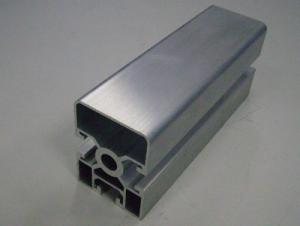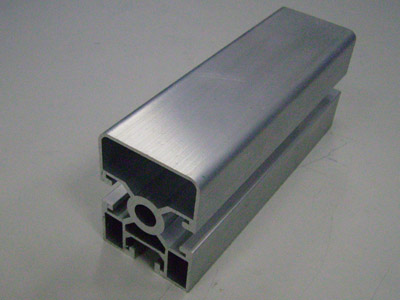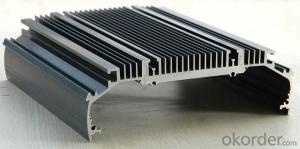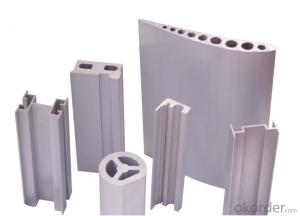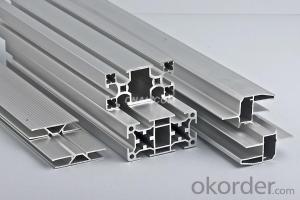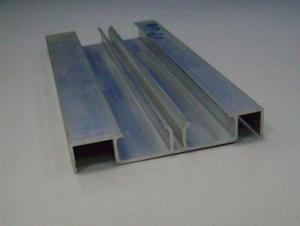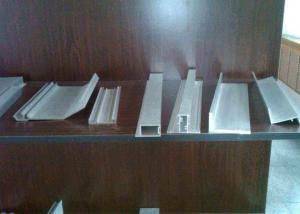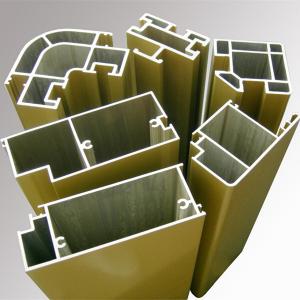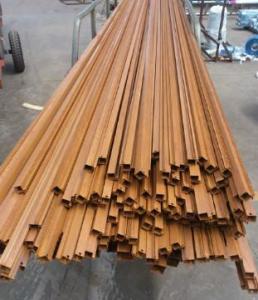Aluminum Siding Trim Profiles - Aluminum Extrusion Profile
- Loading Port:
- China Main Port
- Payment Terms:
- TT OR LC
- Min Order Qty:
- -
- Supply Capability:
- -
OKorder Service Pledge
OKorder Financial Service
You Might Also Like
Aluminium Profile
Our advantages:
1)we can provide"one- stop service from melting,extruding,surface treatment,machining,welding,assembling to mould design & building.
2)we have a good capacity of precise machining,cnc machining.
3)we can provide good quality with reasonable price.
Products:
Description | Aluminium Profiles |
Alloy | Al 6063 T5 /T6 or 6061 or 6005 or as per customers' need |
Finish | Anodizing or powder coating with various colors |
Packing | Foam sheet,poly bag,plastic bag,carton |
Brand | YMJ |
Original place | |
Certificate | ISO9001 |
Equipments:
7extruders,2 six meters long anodizing lines,1 twelve meters long anodizing line(including dyeing & electrolysis).1 powder coating line,5 melting lines,12 CNCs(including 2 machines which can mill 6.5m long profile),10 argon arc welding machines and multiple machines for cutting,drilling,punching,milling,shearing and bending,2 spectrum scanners,1 projective instument,1 extension test machine,1 mechanical property tester,1 Rohs tester and 1 metallurgical microscope.
Service:
We're a well- established manufacture for aluminium products,we're confident we can give our customers complete satisfication.
We can provide good quality with reasonable price.
- Q: How much does aluminum mold need?
- The cost of aluminum profile die is judged according to the size of the profile. The length of the profile diagonal and the length of the profile to be produced have direct influence on the die cost. For example, an outer diameter 60mm diameter 40mm of the aluminum tube, in general circumstances, open a diameter of 178mm, thickness of 120mm mold can be produced. But if you request that the length of the aluminum tube produced is 5 meters or longer, this should be a mold with a diameter of 220mm and a thickness of 138mm, so as to squeeze on a larger machine with a larger bar. Of course, this is only one, for example, specific questions should be analyzed in detail.
- Q: Is it possible to recycle aluminum profiles and use them again in construction projects?
- <p>Yes, aluminum profiles can be recycled and reused in construction. Aluminum is highly recyclable, and the recycling process requires significantly less energy compared to the production of new aluminum. Recycled aluminum maintains its properties, making it suitable for various construction applications. This practice not only conserves resources but also reduces waste and environmental impact.</p>
- Q: This question asks about the measures taken to guarantee that aluminum profiles adhere to safety standards during the installation process.
- <p>To ensure aluminum profiles meet safety standards during installation, follow these steps: 1) Use profiles certified to meet international safety standards such as ISO or ASTM. 2) Employ trained professionals for installation to avoid improper handling or assembly. 3) Regularly inspect the profiles for any signs of damage or wear before and after installation. 4) Adhere to the manufacturer's guidelines and specifications for installation to avoid structural weaknesses. 5) Use appropriate safety gear and equipment during the installation process to protect workers and the public. 6) Conduct load-bearing tests to confirm the structural integrity of the installed profiles. 7) Keep detailed records of all inspections, tests, and installations for future reference and compliance checks.</p>
- Q: Can aluminum profiles be used for window frames?
- Yes, aluminum profiles can be used for window frames. Aluminum is a popular material choice for window frames due to its durability, strength, and resistance to corrosion. It is lightweight, easy to shape, and can withstand various weather conditions, making it a suitable option for window frames. Additionally, aluminum profiles can be customized to fit different window sizes and designs, making them a versatile choice.
- Q: How do you calculate the weight-bearing capacity of aluminum profiles?
- To calculate the weight-bearing capacity of aluminum profiles, you need to consider various factors such as the dimensions of the profile, the material grade of aluminum used, and the specific application requirements. Firstly, determine the dimensions of the aluminum profile, including the length, width, and thickness. These measurements will help you calculate the cross-sectional area of the profile, which is a crucial parameter in determining its load-bearing capacity. Next, consider the material grade of aluminum used in the profile. Aluminum alloys have different strength properties, so it is essential to know the specific alloy and temper designation. This information can be obtained from the manufacturer or supplier. Once you have the cross-sectional area and material grade, you can refer to engineering standards or handbooks that provide load tables or formulas for calculating the safe load capacity of aluminum profiles. These resources usually provide a range of load ratings based on different loading conditions, such as static or dynamic loads, and factors like span length, support conditions, and safety factors. It is crucial to consider the specific application requirements and any additional factors that may affect the load-bearing capacity, such as temperature, vibration, or potential impact forces. These factors may require further adjustments to the calculated load capacity. Additionally, consulting with a structural engineer or an aluminum profile manufacturer can provide valuable insights and recommendations for calculating the weight-bearing capacity more accurately. They may have specialized knowledge or testing data specific to the aluminum profile in question, ensuring a more reliable calculation. Overall, calculating the weight-bearing capacity of aluminum profiles involves considering the dimensions, material grade, specific application requirements, and consulting relevant resources or experts in the field to ensure accurate and safe load calculations.
- Q: Identify the key elements to evaluate when choosing aluminum profiles for a particular project.
- <p>When selecting aluminum profiles for a specific project, consider the following factors: 1) Load-bearing capacity, ensuring the profile can support the intended weight and stress; 2) Dimensional stability, to maintain structural integrity over time; 3) Corrosion resistance, especially for outdoor or humid environments; 4) Aesthetics, matching the profile's appearance with the project's design; 5) Cost-effectiveness, balancing quality with budget constraints; 6) Availability of the profile, considering lead times and supply chain reliability; 7) Ease of fabrication and assembly, which can affect construction time and labor costs; 8) Thermal properties, important for energy efficiency in buildings; 9) Compliance with industry standards and regulations; 10) Customizability, for projects with unique specifications or design requirements.</p>
- Q: This question asks about the various types of protective coatings applied to aluminum profiles to enhance their durability and resistance to environmental factors.
- <p>Aluminum profiles are coated with different materials to protect them from corrosion and enhance their appearance. Some common coatings include: anodizing, which creates a hard, corrosion-resistant oxide layer on the surface; powder coating, a durable and versatile method that provides a wide range of colors and finishes; electrophoretic coating (E-coating), which offers a smooth, even coating for corrosion resistance; and thermal spraying, which applies a protective layer through a high-velocity flame process. Each coating serves a specific purpose, such as improving durability, resistance to UV rays, or simply for aesthetic reasons.</p>
- Q: Can aluminum profiles be used in the production of consumer electronics?
- Yes, aluminum profiles can be used in the production of consumer electronics. Aluminum profiles are lightweight, strong, and durable, making them suitable for various applications in the electronics industry. They can be used as housing or enclosures for devices such as smartphones, laptops, tablets, and audio equipment. The versatility of aluminum profiles allows for customization and easy integration of components, ensuring proper functioning and protection of electronic devices. Additionally, aluminum profiles can be anodized or coated to provide a sleek finish and enhance corrosion resistance, further adding to their appeal in consumer electronics production.
- Q: This question asks for a list of various uses of aluminum profiles in the construction of buildings.
- <p>Aluminum profiles have versatile applications in building construction due to their strength, durability, and lightweight properties. They are used in curtain walls, window and door frames, structural glazing, and as support systems for facades. Aluminum profiles also serve as components in roofing systems, sunshades, and canopies. They are employed in the construction of balconies, handrails, and stairways for their corrosion resistance and ease of maintenance. Furthermore, aluminum profiles are utilized in the manufacturing of modular buildings and prefabricated structures, as well as in the creation of interior partitions and office cubicles. Their adaptability makes them a popular choice for both commercial and residential construction projects.</p>
- Q: What are the benefits of using aluminum profiles in interior design?
- There are several benefits of using aluminum profiles in interior design. Firstly, aluminum profiles are highly versatile and can be used in a wide range of applications. They can be easily customized and fabricated to fit different design requirements. Whether you are designing a modern, minimalist space or a traditional, ornate interior, aluminum profiles offer a flexible solution. Secondly, aluminum profiles are lightweight yet durable, making them an ideal choice for interior design. They are resistant to corrosion, moisture, and temperature changes, ensuring a long lifespan. This durability also means that aluminum profiles require minimal maintenance, saving both time and money in the long run. Another benefit of using aluminum profiles is their aesthetic appeal. They come in a variety of finishes, colors, and textures, allowing designers to achieve their desired look and feel. Aluminum profiles can be anodized, powder-coated, or polished, giving them a sleek and modern appearance. They can also be designed to mimic other materials, such as wood or stainless steel, while offering the added benefits of aluminum. Additionally, aluminum profiles offer excellent thermal and acoustic insulation properties. They can help regulate temperature and reduce noise levels, creating a more comfortable and peaceful environment. This is especially beneficial in areas where soundproofing or energy efficiency is required, such as offices, hotels, or residential spaces. Lastly, aluminum profiles are eco-friendly and sustainable. Aluminum is a highly recyclable material, and using aluminum profiles in interior design helps reduce waste and minimize environmental impact. Moreover, aluminum profiles can contribute to energy efficiency by allowing natural light to enter a space, reducing the need for artificial lighting during the day. In conclusion, the benefits of using aluminum profiles in interior design are versatility, durability, aesthetic appeal, thermal and acoustic insulation, and sustainability. These qualities make aluminum profiles a popular choice among designers and architects looking to create functional and visually appealing spaces.
Send your message to us
Aluminum Siding Trim Profiles - Aluminum Extrusion Profile
- Loading Port:
- China Main Port
- Payment Terms:
- TT OR LC
- Min Order Qty:
- -
- Supply Capability:
- -
OKorder Service Pledge
OKorder Financial Service
Similar products
Hot products
Hot Searches
Related keywords
